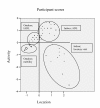Relationship between location and activity in injurious falls: an exploratory study
- PMID: 20565871
- PMCID: PMC2902483
- DOI: 10.1186/1471-2318-10-40
Relationship between location and activity in injurious falls: an exploratory study
Abstract
Background: Knowledge about the circumstances under which injurious falls occur could provide healthcare workers with better tools to prevent falls and fall-related injuries. Therefore, we assessed whether older persons who sustain an injurious fall can be classified into specific fall types, based on a combination of fall location and activity up to the moment of the fall. In addition, we assessed whether specific injurious fall types are related to causes of the fall, consequences of the fall, socio-demographic characteristics, and health-related characteristics.
Methods: An exploratory, cross-sectional study design was used to identify injurious fall types. The study population comprised 333 community-dwelling Dutch elderly people aged 65 years or over who attended an accident and emergency department after a fall. All participants received a self-administered questionnaire after being discharged home. The questionnaire comprised items concerning circumstances of the injurious fall, causes of the fall, consequences of the fall, socio-demographic characteristics and health-related characteristics. Injurious fall types were distinguished by analyzing data by means of HOMALS (homogeneity analysis by means of alternating least squares).
Results: We identified 4 injurious fall types: 1) Indoor falls related to lavatory visits (hall and bathroom); 2) Indoor falls during other activities of daily living; 3) Outdoor falls near the home during instrumental activities of daily living; 4) Outdoor falls away from home, occurring during walking, cycling, and shopping for groceries. These injurious fall types were significantly related to age, cause of the fall, activity avoidance and daily functioning.
Conclusion: The face validity of the injurious fall typology is obvious. However, we found no relationship between the injurious fall types and severity of the consequences of the fall. Nevertheless, there appears to be a difference between the prevalence of fractures and the cause of the fall between the injurious fall types. Our data suggests that with regard to prevention of serious injuries, we should pay special attention to outdoor fallers and indoor fallers during lavatory visits. In addition, we should have special attention for causes of the fall. However, the conclusions reached in this exploratory analysis are tentative and need to be validated in a separate dataset.
Figures

References
-
- Gillespie LD, Gillespie WJ, Robertson MC, Lamb SE, Cumming RG, Rowe BH. Interventions for preventing falls in elderly people. Cochrane Database Syst Rev. 2003. p. CD000340. - PubMed
Publication types
MeSH terms
LinkOut - more resources
Full Text Sources
Medical

